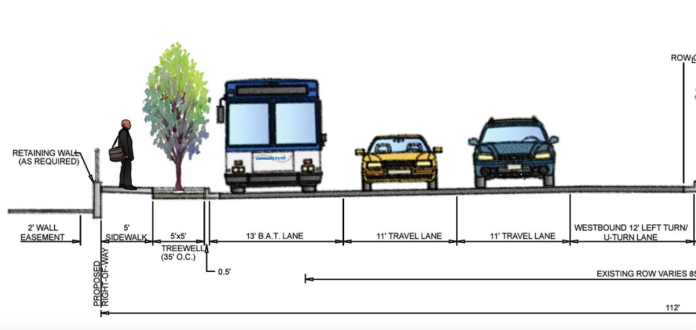Lynnwood is on a path toward disaster with its latest stroad designs for 196th St SW, a road bisecting the city’s regional growth center near the Lynnwood Transit Center (also future terminus of light rail in 2023). 196th St SW is a primary arterial street linking together the communities of Edmonds, Lynnwood, Bothell, and Maltby. The project is supposed to “enhance” a 12-block stretch of road from 36th Ave W to 48th Ave W within the city center. Lynnwood recently issued their SEPA (State Environmental Policy Act) determination on the project proposal that would expand an already-wide right-of-way from 85 feet to a freeway-style 112 feet.
Under the proposal, the total number of lanes would increase from five to seven. This is cause for concern if Lynnwood is serious about forging a city center in an urban image around its light rail station. Just this week Lynnwood Mayor Nicola Smith told The Seattle Times her downtown is “ground ready” to welcome people and buildings. This proposal suggests it’s more interested in pampering cars.
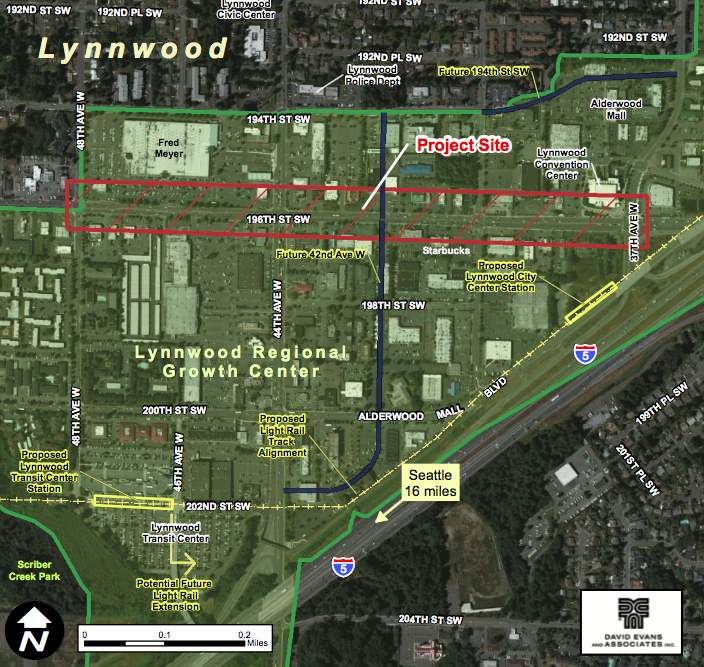
Shotgun “Mitigation”
The City of Lynnwood claims that its SEPA determination has proposed adequate mitigation measures for environmental impacts associated with the project using a shotgun approach:
1. The project will implement the City’s adopted City Center Plan and City Center Streetscape element with landscaped medians, pedestrian refuge islands at key intersections, wider sidewalks set back from the curb, illumination, underground utilities, and street trees in tree grates on both sides of the street.
2. Safety and security will improve due to new sidewalks, signal upgrades, improved pedestrian and roadway illumination, and a new raised median separating opposing traffic.
3. The project will improve the safety of business access with a dedicated Business Access and Transit (BAT) lane, re-striped parking lots to minimize loss of parking, and u-turn movements at intersections, which will mitigate for the loss of the two-way left-turn lane.
4. The additional two general purpose lanes, left-turn pockets at intersections, u-turn movements, signal upgrades, and BAT lane will increase capacity and mobility, decreasing congestion and delay.
5. New sidewalks and improved property access points will encourage non-motorized travel, improving non-motorized connections into and throughout City Center.
Can I just point out they actually said “pedestrian refuges”? If that doesn’t instill concern on its own, the rest of the car-obsessed mitigation proposal should.
Lynnwood might say that adding BAT (business access and transit) lanes, a measly expansion of the sidewalk environment, and very thin pedestrian refuges at crosswalks is sufficient. But the plan puts people walking and biking in third class, induces higher road speeds, adds pollution, reduces safety for pedestrians and bicyclists, and jeopardizes the future success of a planned town center with access to high quality light rail. How many great walkable urban districts can you say have a seven-lane highway plowing through the middle of them? How many plans to densify a “city center” begin with seizing a 27-feet wide swath of developable real estate and paving it over for highway widening?
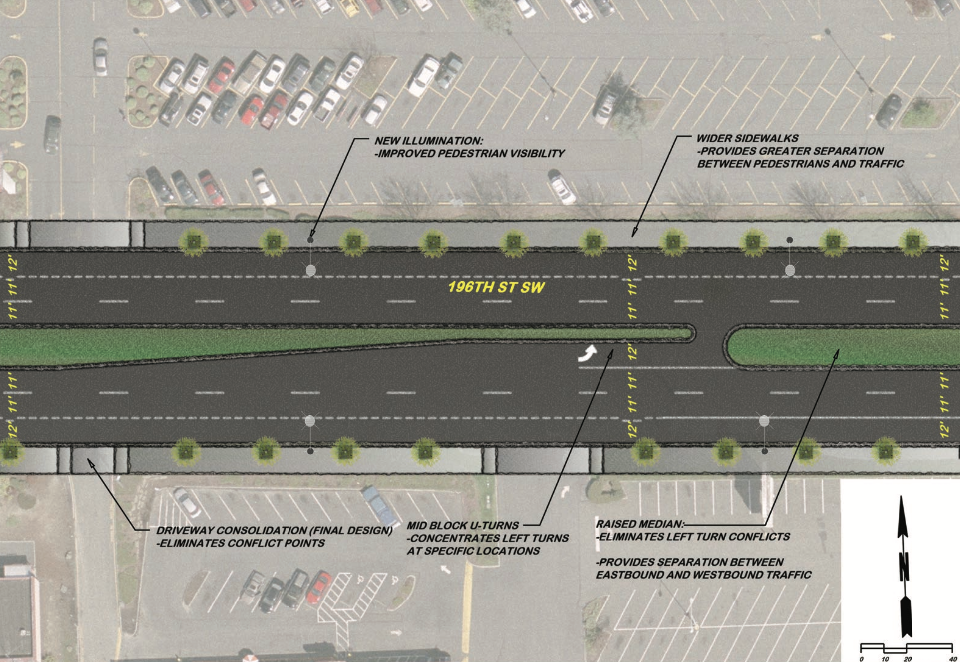
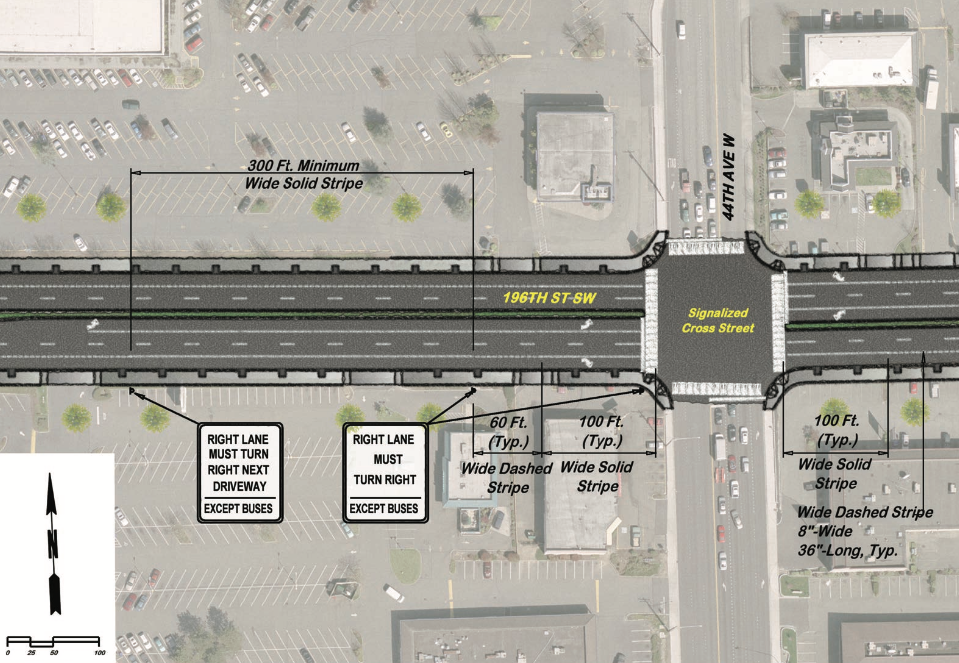
The proposed cross-section speaks for itself: two general purpose lanes plus one BAT lane in each direction, a rotating left turn pocket and median, and a minor curb-to-sidewalk separation and meager five-foot sidewalk on each side (plus a five-foot treewell that buffers the roadway but cuts down on navigable space).
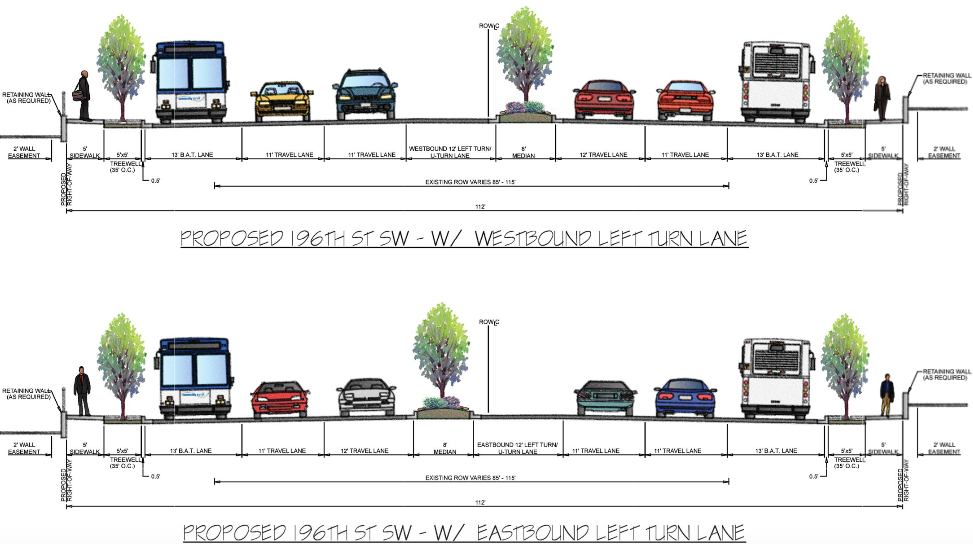
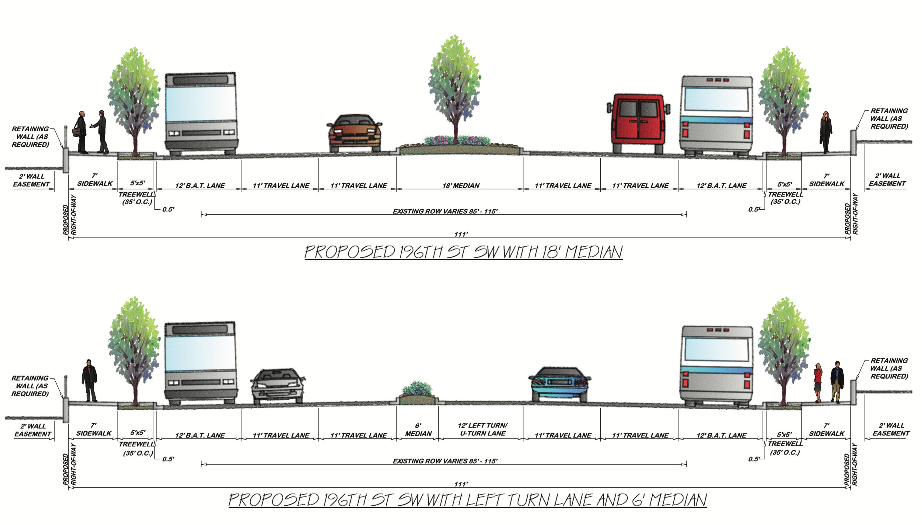
Threatening A Regional Growth Center
Lynnwood’s city center has a lot going on. For starters, Sound Transit plans to open its northernmost Link station at the Lynnwood Transit Center by 2023, which is just a few blocks south of 196th St SW. Three major private developments are under construction, including: a six-story, 150-room Hilton hotel; an eight-story senior housing apartment building with 308 units; and a seven-story affordable housing apartment building with 347 units. The large parcels of land and relatively connectable grid certainly lend themselves to a walkable, mixed-use urban district. Lynnwood’s city center plan also has the right bones in it to incentivize high-rise and mid-rise construction throughout. Things like a better, more multimodal 196th St SW design would flesh out those bones.
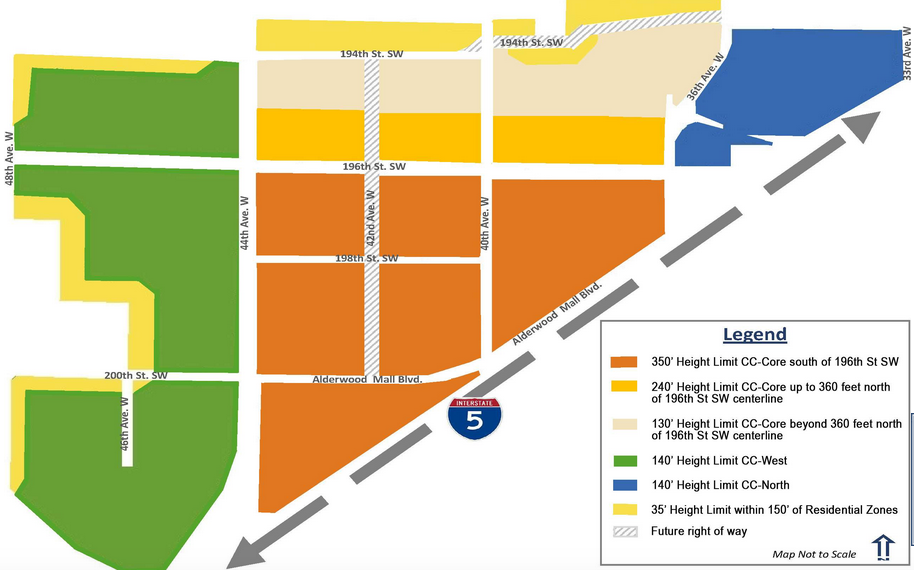
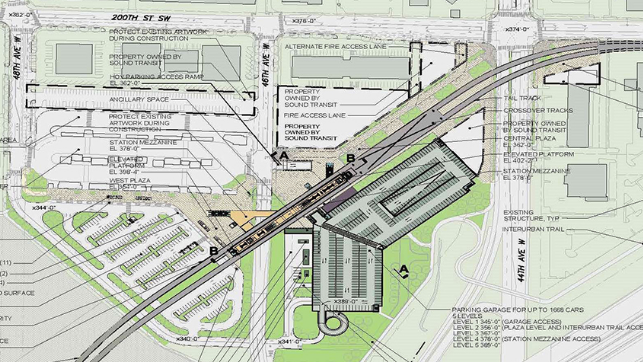
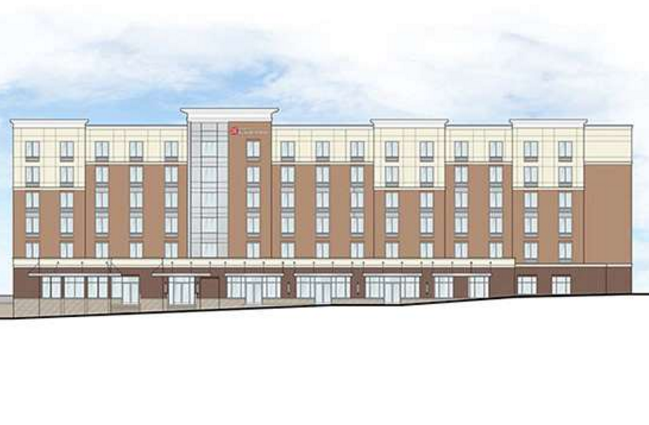
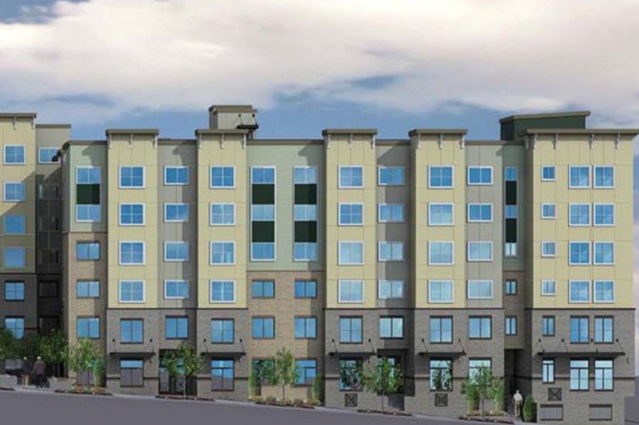
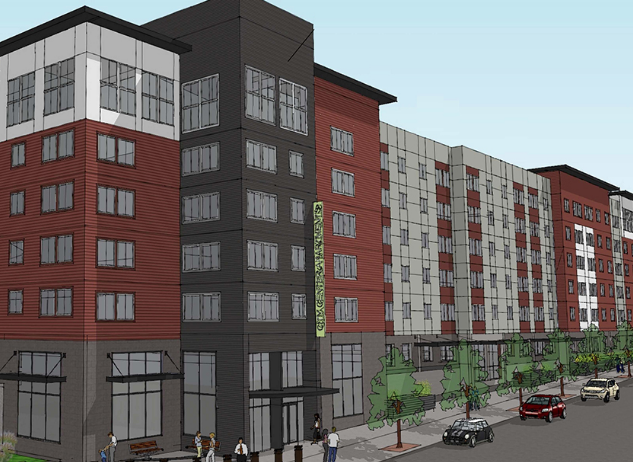
Lynnwood will undoubtedly continue grow as light rail inches its way closer, but a stroad on steroids will permanently sever the two sides of a regional growth center likely kneecapping its ability to function as a desirable place to live, work, and play.
A Better Alternative
If Lynnwood wants to get serious about its city center, building a stroad isn’t the way to invest in it. For starters, seven lanes are excessive and unnecessary, so let’s just cast that idea away. A BAT lane has value, especially given that Community Transit may add a future Swift route on it; swap out one general purpose lane in each direction for BAT and then bump up the width of the planter strips or even try the earth-shattering idea of providing more than five-foot wide sidewalks.
Lynnwood could go further by adding mid-block crosswalks (half light crossing) on long-blocks so that pedestrians aren’t stranded with walking four blocks to the next crossing. Time the lights to provide frequent changes to allow pedestrians to cross instead of relegating them to ridiculous waits. Missing entirely from the plans are bicycle facilities. With light rail going in at 46th Ave W, the right answer seems to be that bike lanes should be installed on streets crossing 196th St SW to build a network on lower use and speed streets. The best candidates for that seem to be 48th Ave W and 46th Ave W, but the plans don’t involve anything that would provide safe facilities for bicyclists.
I understand converting an existing lane to a BAT lane is the type of thing that riles up some motorists, fills up inboxes, and causes headaches for City officials. However, if Lynnwood is serious about changing from a car-centric sprawled-out suburb to a balanced city with a vibrant core, it needs to take pedestrian mobility seriously; it can’t proceed with a seven-lane monstrosity on 196th St SW. A municipality can’t simply pass an aspirational city center plan and expect everything to magically change. The city council needs to follow through and make tough choices to make it a reality.
The project is probably a done deal since its been in planning for well over four years, but that shouldn’t stop urban advocates from raising red flags now. The SEPA comment period is open through 4pm tomorrow (November 4th). So if you care about quality urban places, now’s the time provide your feedback. Let project manager, David Mach, know that this design is a dud and that Lynnwood needs to rethink how an urban district should work. You can reach him at dmach@lynnwoodwa.gov.
Doug Trumm is publisher of The Urbanist. An Urbanist writer since 2015, he dreams of pedestrian streets, bus lanes, and a mass-timber building spree to end our housing crisis. He graduated from the Evans School of Public Policy and Governance at the University of Washington in 2019. He lives in Seattle's Fremont neighborhood and loves to explore the city by foot and by bike.

